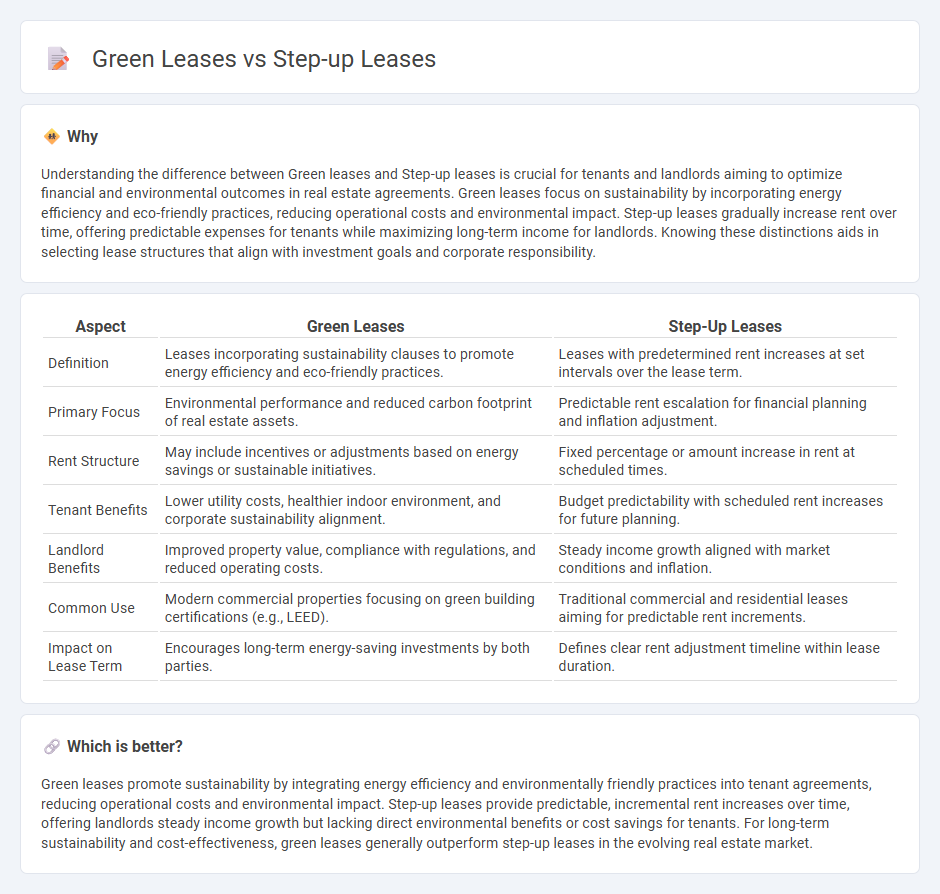
Green leases prioritize energy efficiency and sustainability by integrating environmental obligations between landlords and tenants, reducing operating costs and carbon footprints. Step-up leases, on the other hand, involve predetermined rental increases over time, providing predictable revenue growth for landlords. Discover how these lease structures impact property values and tenant relationships.
Why it is important
Understanding the difference between Green leases and Step-up leases is crucial for tenants and landlords aiming to optimize financial and environmental outcomes in real estate agreements. Green leases focus on sustainability by incorporating energy efficiency and eco-friendly practices, reducing operational costs and environmental impact. Step-up leases gradually increase rent over time, offering predictable expenses for tenants while maximizing long-term income for landlords. Knowing these distinctions aids in selecting lease structures that align with investment goals and corporate responsibility.
Comparison Table
| Aspect | Green Leases | Step-Up Leases |
|---|---|---|
| Definition | Leases incorporating sustainability clauses to promote energy efficiency and eco-friendly practices. | Leases with predetermined rent increases at set intervals over the lease term. |
| Primary Focus | Environmental performance and reduced carbon footprint of real estate assets. | Predictable rent escalation for financial planning and inflation adjustment. |
| Rent Structure | May include incentives or adjustments based on energy savings or sustainable initiatives. | Fixed percentage or amount increase in rent at scheduled times. |
| Tenant Benefits | Lower utility costs, healthier indoor environment, and corporate sustainability alignment. | Budget predictability with scheduled rent increases for future planning. |
| Landlord Benefits | Improved property value, compliance with regulations, and reduced operating costs. | Steady income growth aligned with market conditions and inflation. |
| Common Use | Modern commercial properties focusing on green building certifications (e.g., LEED). | Traditional commercial and residential leases aiming for predictable rent increments. |
| Impact on Lease Term | Encourages long-term energy-saving investments by both parties. | Defines clear rent adjustment timeline within lease duration. |
Which is better?
Green leases promote sustainability by integrating energy efficiency and environmentally friendly practices into tenant agreements, reducing operational costs and environmental impact. Step-up leases provide predictable, incremental rent increases over time, offering landlords steady income growth but lacking direct environmental benefits or cost savings for tenants. For long-term sustainability and cost-effectiveness, green leases generally outperform step-up leases in the evolving real estate market.
Connection
Green leases incorporate clauses promoting energy efficiency and sustainability, aligning with environmental goals in real estate contracts. Step-up leases feature rent increases at predetermined intervals, which can be structured to fund eco-friendly building improvements outlined in green leases. This connection incentivizes landlords and tenants to invest in sustainability upgrades while managing financial planning through incremental rent adjustments.
Key Terms
Rent Escalation
Step-up leases feature predetermined rent increases at specific intervals, providing landlords predictable revenue growth while tenants anticipate gradual cost increments. Green leases incorporate rent escalation tied to sustainability targets or operational cost savings, aligning financial incentives with environmental performance improvements. Explore further to understand how these lease structures impact long-term financial and environmental strategies.
Sustainability Clauses
Step-up leases incorporate sustainability clauses that gradually increase tenant obligations for energy efficiency and environmental performance over time, encouraging continuous improvement in building operations. Green leases embed sustainability terms that promote shared responsibility between landlords and tenants for implementing eco-friendly practices, such as waste reduction and resource conservation. Explore how these lease structures drive sustainable property management and reduce carbon footprints in commercial real estate.
Operating Expenses
Step-up leases involve gradual increases in rent or operating expenses over time, allowing landlords to cover rising costs such as maintenance, utilities, and property taxes. Green leases integrate sustainability clauses that encourage tenants and landlords to share responsibility for reducing operating expenses through energy efficiency, waste reduction, and sustainable building management practices. Explore the benefits and impacts of both lease types on operating expenses to optimize your commercial property strategy.
Source and External Links
The Power of Rent Step ups: A Closer Look at Step-Up Leases - Step-up leases are long-term commercial lease agreements with predetermined incremental rent increases, providing stability and predictability for landlords and tenants while protecting against inflation and market changes.
Step-Up Lease (Graded Lease) - A step-up lease involves rent increasing in predetermined increments over the lease term, commonly used in commercial real estate to manage inflation and changing market conditions with legal binding when documented properly.
Step up lease - Also called graduated or escalation leases, step-up leases periodically increase rent by fixed or indexed amounts, allowing landlords to secure rising income and tenants to plan budgets effectively in long-term rental agreements.
 dowidth.com
dowidth.com